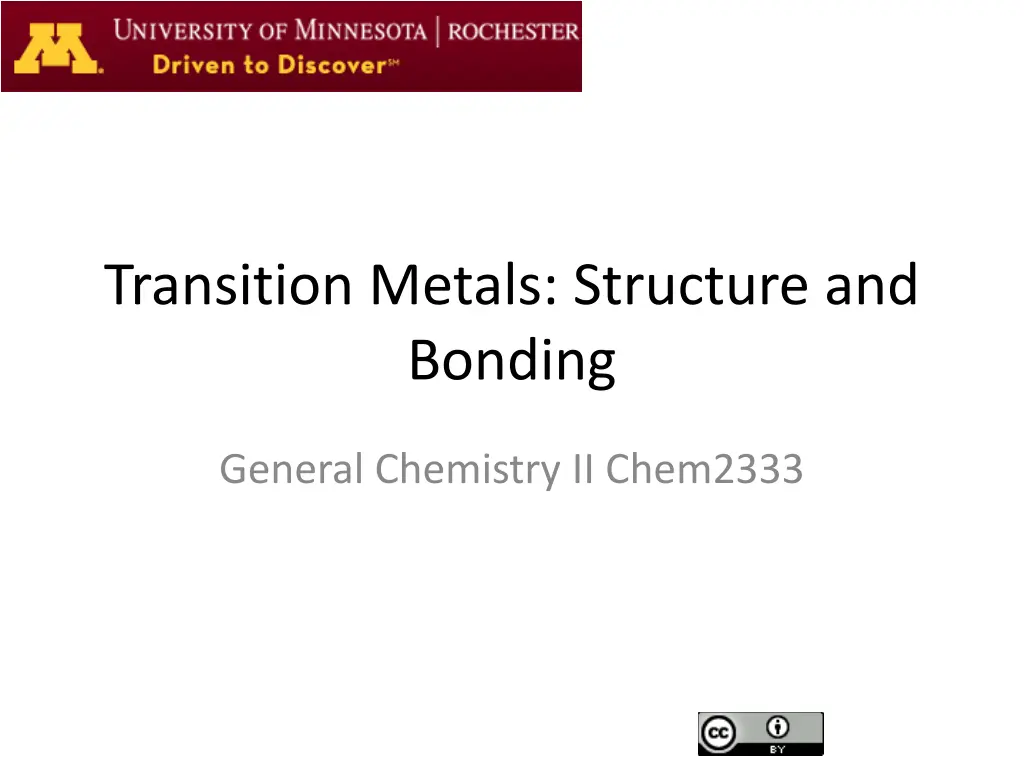
Understanding Transition Metals: Structure, Bonding, and Spectrochemistry Explained
Explore the fascinating world of transition metals, including their structures, bonding theories, and spectrochemical properties. Learn about ligand field theory, crystal field theory, d-orbitals, and the spectrochemical series in coordination compounds. Discover how these concepts help in understanding the behavior of transition metals in chemical reactions.
Download Presentation

Please find below an Image/Link to download the presentation.
The content on the website is provided AS IS for your information and personal use only. It may not be sold, licensed, or shared on other websites without obtaining consent from the author. If you encounter any issues during the download, it is possible that the publisher has removed the file from their server.
You are allowed to download the files provided on this website for personal or commercial use, subject to the condition that they are used lawfully. All files are the property of their respective owners.
The content on the website is provided AS IS for your information and personal use only. It may not be sold, licensed, or shared on other websites without obtaining consent from the author.
E N D
Presentation Transcript
Transition Metals: Structure and Bonding General Chemistry II Chem2333
Transition Metals Module 6 Session 7 1. Video 1: Ligand field theory 1. Octahedral field 2. Spectrochemical series 2. Video 2: Ligand field theory: magnetism 1. Low spin and high spin complexes 3. Video 3: LIgand field theory: other fields 1. Tetrahedral 2. Square planar 4. Video 4: Problem solving Chem 2333: General Chemistry II 2
Detecting Hypoxia The Pulse Oxymeter is a device to detect oxygen saturation in patient s tissue. It s a small spectrophotometer Oxyhemoglobin Deoxyhemoglobin Absorbs at 660nm (color red) Absorbs at 940nm (color blue/purple) Chem 2333: General Chemistry II 3
Crystal field theory (CFT) 4p CFT focuses on this part only Vanadium: V 3d 6 H2O 2p Electronic transition outside of the d orbital will be too energetic, beyond visible light 4s Chem 2333: General Chemistry II 4
d-Orbitals Absent ligands the orbitals are degenerate, they have the same energy... Ligand Field Theory: An electrostatic model (i.e. not technically a bonding model) It will attempt to explain what happens to the Molecular Orbitals in Coordination Compounds. (sometimes called Crystal Field Theory) Chem 2333: General Chemistry II 5
What is the electrostatic (+/-) nature of the ligand? What is the electrostatic (+/-) nature of an orbital? Will each d-orbital increase or decrease in energy? Ligand Field Theory Chem 2333: General Chemistry II 6
Octahedral Ligand Field Oh Oh is the Ligand Field Splitting energy. In this case an octahedral ligand field (Oh). The size of Oh depends on the ligands and will determine spectroscopic and magnetic properties. Chem 2333: General Chemistry II 7
Spectrochemical Series increasing strong field ligand large weak field ligand small en = Bidentate ligand binds twice to the metal ion Derived from measurements Chem 2333: General Chemistry II 8
Spectrochemical Series Numbers are nm So which compound has a larger split? Chem 2333: General Chemistry II 9 9
Magnetism Bulk: many molecules Even if a substance has unpaired electrons, the molecular electron spins are randomly pointing to all the directions and no net magnetic field is produced. Only when we apply an external magnetic field (with a magnet) the electron spins align and a magnetic field is induced. (Think of the refrigerator magnets) NMR works in a similar way but with nuclear spins. Some paramagnetic substances are able to keep this alignment (all molecule s spins pointing to one direction) even when no external magnetic field is applied. This is the case of some compounds of Fe, Co, Ni. They are called ferromagnetic and they are used as magnets. Chem 2333: General Chemistry II 10
Magnetism Some substances are attracted by an external magnetic field (e.g. magnet) and they are called paramagnetic. Other substances are not attracted and they are called diamagnetic. Paramagnetic substance will have unpaired electrons. The molecule will generate a net magnetic field Diamagnetic substance won t have any unpaired electrons Chem 2333: General Chemistry II 11
Low-Spin and High-Spin Complexes Pauli exclusion principle is stronger than coulomb interactions (Pauli wins!) Coulomb interactions are stronger than Pauli exclusion principle (Aufbau wins!) diamagnetic paramagnetic low-spin complex high-spin complex only electron configurations d4, d5, d6, or d7 can have low or high spin Chem 2333: General Chemistry II 12
Low-Spin and High-Spin Complexes Draw the possible low spin and high spin electronic configurations in octahedral complexes for the following number of d electrons: d4: d5: d6: d7: Chem 2333: General Chemistry II 13
Crystal field theory: Tetrahedral In general the orbital splitting in tetrahedral will be much lower than in octahedral tetrahedral < octahedral Only high-spin tetrahedral complexes are known Chem 2333: General Chemistry II 14
Crystal field theory: Square planar Chem 2333: General Chemistry II 15
t=0.44o Small split in Tetradhedral No low spin complexes sp=1.74 o For a tetrahedral complex to be stable it has to have more electrons in the e level than t Most square planar complexes are d8. What is the electronic configruation in cisplatin (one of the first cancer drug). Chem 2333: General Chemistry II 16
Crystal field theory: problem solving The absorption maximum for the complex ion [Co(NH3)6]3+ occurs at 470 nm. What is the color of the complex and what is the crystal field splitting in kJ/mol? Chem 2333: General Chemistry II 17
Crystal field theory: problem solving Explain the differences in color of these two compounds: [Cr(NH3)6]3+ [Cr(NH3)5Cl]2+ Numbers are nm Chem 2333: General Chemistry II 18
Crystal field theory: problem solving What color would we expect an aqueous solution containing Ti(OH2)44+ to be? 1. blue 2. red 3. green 4. yellow 5. colorless Chem 2333: General Chemistry II 19






















